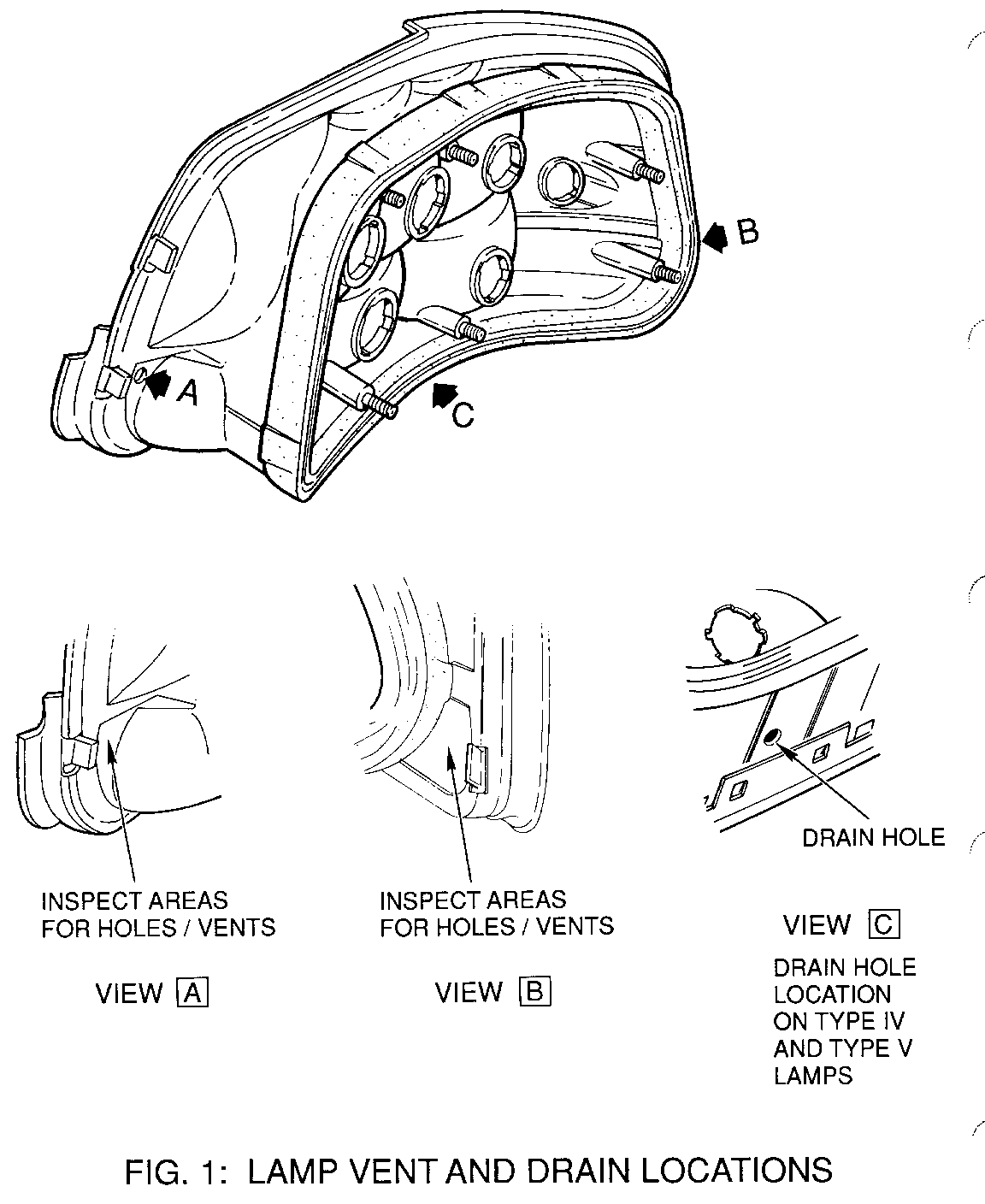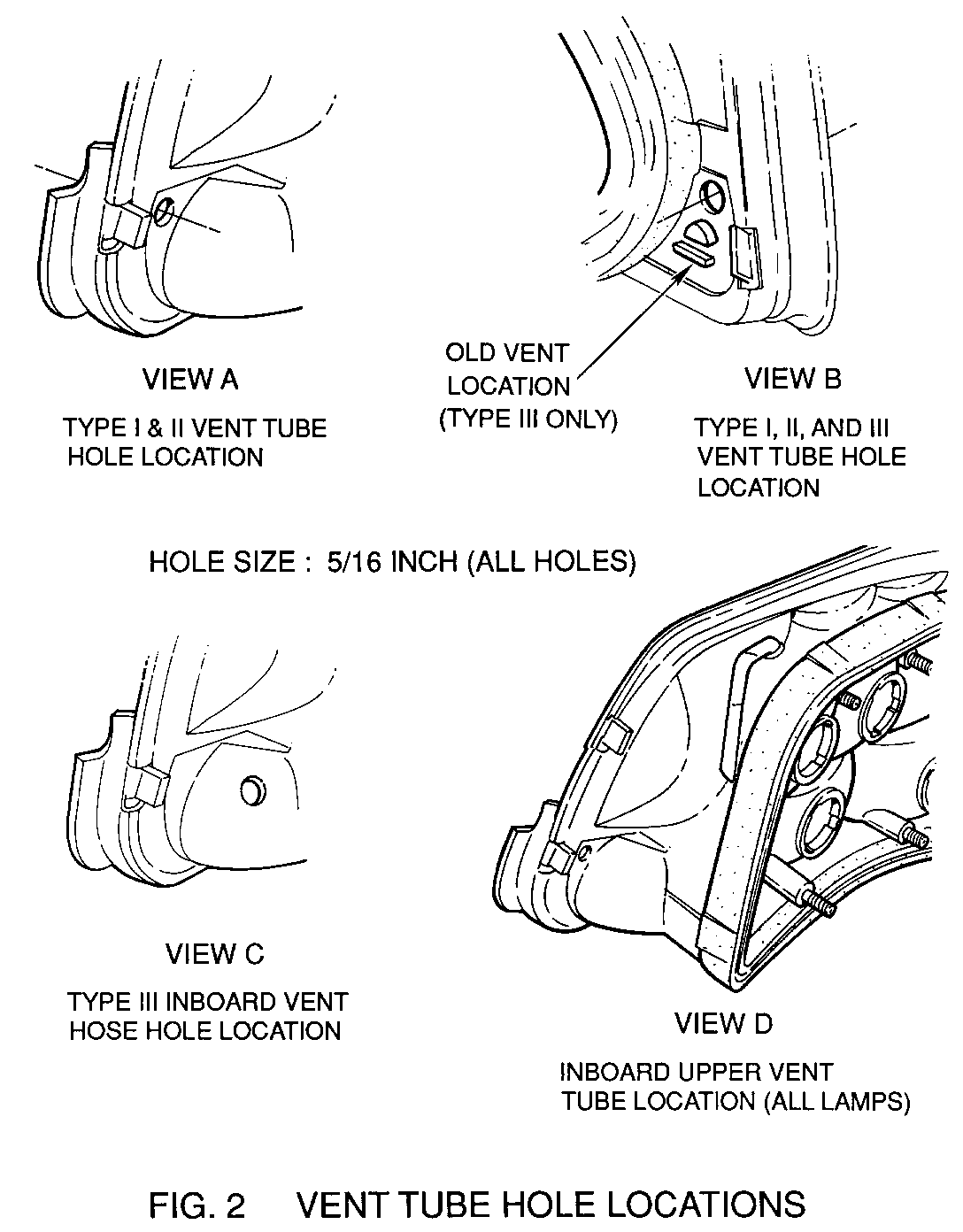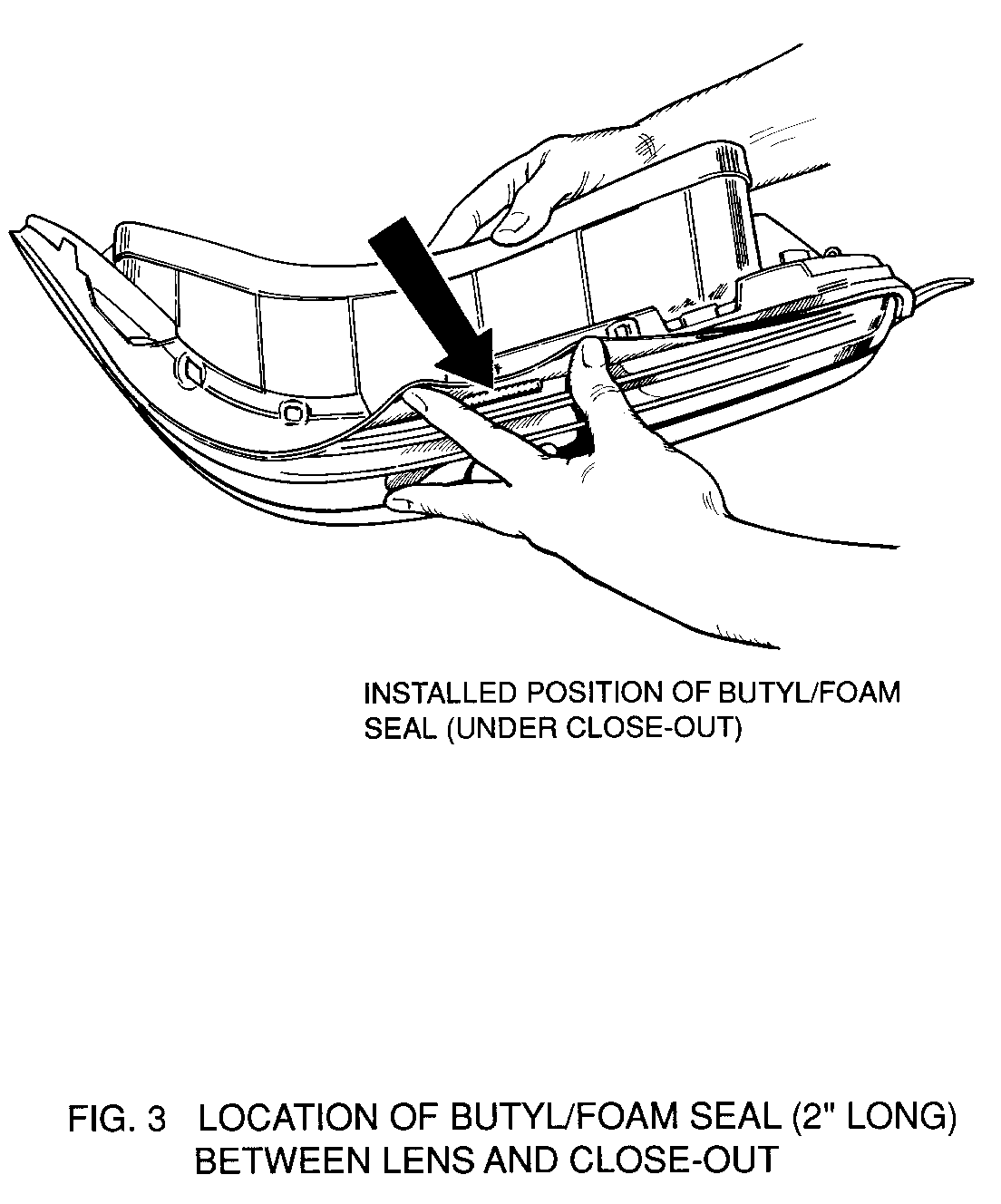CONDENSATION/WATER IN TAIL LAMPS (NEW SERVICE PROCEDURE)

SUBJECT: CONDENSATION/WATER IN TAIL LAMPS (NEW SERVICE PROCEDURE)
VEHICLES AFFECTED: 1988-90 PONTIAC GRAND PRIX
THIS BULLETIN CANCELS AND REPLACES BULLETINS #88-2-182, AND 90-2-112.
CONDITION: Some 1988, 1989, and 1990 Pontiac Grand Prix tail lamps may exhibit condensation or water inside the lamp housing.
CAUSE: There are two possible causes for the condition:
1. Certain atmospheric conditions which include cool evenings after humid days, and washing the vehicle during warm humid days may cause condensation on the inside of the lens. These conditions allow warm humid air to enter the lamp assembly, and the moisture in the air will condense on the lens when the lens is cooled from the outside.
2. A poor seal between the lamp housing and the lens may let liquid water enter. Heat from the bulbs in the lamp may evaporate some of the water, which will then condense on the lens.
CORRECTION: The lamps have been equipped with a water management system which includes provisions for draining on all lamps. Some lamps were also equipped with vents in order to provide a way for the moisture which is evaporated by normal use of the lamps to escape.
IMPORTANT: SMALL AMOUNTS OF CONDENSATION IN THE LAMPS SHOULD CLEAR WITH NORMAL USE OF THE LAMPS.
Customer comments regarding moisture or water in the lamps should be addressed by performing the following procedure. This procedure requires the use of the lamp resealing/venting kit, P/N 10193801. One kit is necessary for each lamp.
NOTE: THIS PROCEDURE ALSO CONTAINS INFORMATION THAT MAY BE USED WHEN REPLACEMENT OF ONLY THE OUTER LENS OF THE LAMP ASSEMBLY IS NECESSARY (DUE TO COLLISION OR SIMILAR DAMAGE). IN THIS CASE, A NEW SEAL MATERIAL IS AVAILABLE AS P/N 10193836.
1. Remove the lamp assembly from the vehicle.
2. Inspect the lamp in the areas shown in Figure 1 to determine the type of water management system. Views A and B show possible locations of vent holes at the lower corners, and View C shows possible location of drain hole at bottom surface of housing.
TYPE I: No drain hole on bottom surface of housing. No vents at lower corners of lamp.
TYPE II: No drain hole on bottom surface of housing. Vent holes at lower corners of lamp.
TYPE III: No drain hole on bottom surface of housing. Hooded vent holes at lower corners of lamp.
TYPE IV: Drain hole on bottom surface of housing. Hooded vent holes at lower corners of lamp. Foam glued to housing near vent holes.
TYPE V: Drain hole on bottom surface of housing. Vent holes at lower corners of lamp surrounded on ALL sides.
3. If the lamp is a type I, II, or III, proceed to step 4. If the lamp is a type IV or V, tape off the bottom drain hole, and all of the bulb holes and fully submerge the lamp in water. Rotate the lamp under water and inspect for air leaking out at the seal between the housing and the outer lens. INITIAL TESTING OF TYPES I, II, AND III ARE NOT NECESSARY AS THE ORIGINAL SEAL WILL BE REPLACED.
a. If the lamp leaks, the seal must be replaced. Continue with step 4.
b. If no leak was detected, add the additional upper vent tube as described in step 10, and reinstall the lamp.
4. Bend the retaining tabs on the clips holding the lens to the housing. Access to the tabs is gained by folding back the rubber close-out moulding in the area of the clips. There are 4 ( of 6) accessible tabs, 3 along the bottom of the lamp and 1 on the upper outboard corner where the lamp wraps around the vehicle.
5. Carefully pry the lens from the lamp housing starting at the lower inboard corner.
6. Remove the close-out moulding from housing.
7. Remove the retaining clips from the housing.
8. Remove all the old seal material (butyl) from the housing and lens.
Important: If the housing is a type IV or V, save some of the sealing material, as it will be necessary later.
9. If the lamp is a style I,II,or III, cover the inboard and outboard drain slots on the lens using overlapping pieces of black electrical tape. The tape should be carefully applied in such a way as to prevent water from entering the lamp at the slot when the lamp is resealed. Only the centre slot should be open. If a new lens is obtained, check the lens for drain slots. If drain slots are not present, and the lamp is a type I,II, or III, drill a 5/16 hole in the bottom edge of the lens at the location of the centre drain slot on the old lens.
10. Add the vent tubes to the lamp housing as follows:
IMPORTANT: Tubes are to be installed from the inside of the lamp housing to the outside. A small amount of liquid soap on the tube eases installation.
Short tube installation: (2 tubes per lamp)
A. Type I, II: drill 5/16 inch (8mm) holes in inboard and outboard lower corners of lamp housing. (On type II, enlarge existing holes) Refer to Figures 2A & B.
Type III: drill 5/16 inch (8mm) holes at lower o/b corner and on side of lower inboard (back-up) lamp cavity. PLUG THE EXISTING VENTS WITH A SMALL AMOUNT OF BUTYL WHICH ORIGINALLY USED TO SEAL THE LAMP. See Figure 2C.
Type IV, V: Short tubes NOT required.
B. Install tubes in holes. Tubes should be pointed down.
C. Trim the final bend off (near the end) of both short tubes.
Long tube installation:
A. All lamp types receive an upper vent tube located above the inboard upper bulb cavity. Drill a 5/16 inch (8mm) hole in this location and install tubes in position shown in Figure 2D.
RH lamp: Use tube part number 16509388 LH lamp: Use tube part number 16509387
The above part numbers are moulded into the side of the tubes. Both tubes are included in the repair kit. These tubes are not available separately.
For type IV and V lamps which do not require resealing, insert a curved piece of wire or a paper clip into the tube and install the tube in the 5/16 in. hole by using the bulb hole for access.
B. Trim the long tube just below the part number moulded in the tube. The part number should remain on the part of the tube attached to the housing.
11. Install close-out moulding on to housing.
12. Install foam/butyl material in lamp housing as outlined below. The material should be placed in the corner formed by the close-out molding and the housing.
IMPORTANT: It is very important that the foam/butyl material is not stretched during installation. An inadequate seal will result.
a. For styles I, II, and III, start the sealing material at the lower centre of the housing at the position of the center drain slot. Trim the material to provide a 1/2 inch (12mm) gap between the ends of the seal.
b. For Styles IV and V, start the sealing material along the center of the lower edge of the housing. Trim the material in order to provide the smallest possible gap between the ends of the seal. Using an adequate amount of the original sealing material (butyl), seal the gap at the ends of the new seal.
13. Install the retaining clips with the tabs toward the centre of the lamp. The lens retaining tab on the clip may need to be bent back in order to form approx. 45 degree angle to the clip.
14. Place the lens face down on a clean protected surface and position the housing on top of it.
15. Push down on the housing in order to seal the lens to the housing
16. On type I, II, and III lamps, install a 2 inch (50mm) length of butyl/foam seal between the lens and the close-out moulding at the location of the centre drain slot. Refer to Figure 3.
17. Reinstall lamp as outlined in the service manual.
18. If lamp was resealed, test new seal by running a large amount of water (i.e. from a garden hose or similar source) over the lamp area for 5 minutes. Liquid water in the bottom of the housing indicates an inadequate seal and resealing is necessary.
IMPORTANT: Some condensation may form on the lens of the lamp during this test if the water is cold and humidity is high. THIS CONDENSATION SHOULD NOT BE MISTAKEN FOR A LEAKING LAMP.



General Motors bulletins are intended for use by professional technicians, not a "do-it-yourselfer". They are written to inform those technicians of conditions that may occur on some vehicles, or to provide information that could assist in the proper service of a vehicle. Properly trained technicians have the equipment, tools, safety instructions and know-how to do a job properly and safely. If a condition is described, do not assume that the bulletin applies to your vehicle, or that your vehicle will have that condition. See a General Motors dealer servicing your brand of General Motors vehicle for information on whether your vehicle may benefit from the information.
